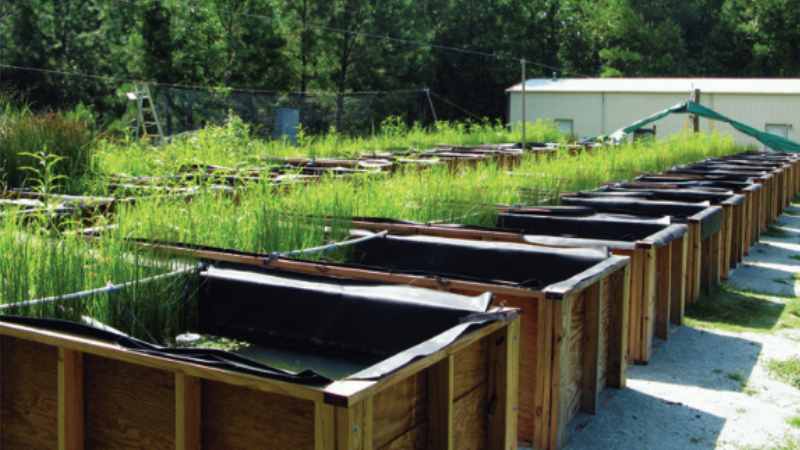Carbon dioxide modules contribute to understanding the environmental impact of nanomaterial
“Vaisala’s probes were fully integratable and could operate in our low-voltage conditions. Calibration of the units was spot on and we started collecting data right away, allowing us to observe some unplanned variances in the controlled environment and make necessary adjustments to experiment design before the research was underway.” Benjamin P. Colman, PhD, Postdoctoral Associate, Center for the Environmental Implications of Nanotechnology

Nanomaterials are big business. The global market for goods based on nanotechnology is predicted to reach to $3.1 trillion in 2015. From titanium dioxide in sunscreen to carbon nanotubes used in flame-retardant fabrics, the use of nanomaterial in food, cosmetics, paint, electronics, textiles and many other goods is booming. As research and development in nanomaterials grows, so does the research to understand their effects on human health and the environment.
Environmental impact of nanomaterials
Understanding how nanomaterials behave and interact with the environment is the research focus of the Center of Environmental Impact of Nanotechnologies (CEINT) based out of Duke University in Durham, North Carolina. CEINT is one of the few research facilities in the world directly testing the impacts of nanomaterials at the ecosystem level. To do this, they have constructed 30 four by twelve foot outdoor experimental wetland ecosystems – mesocosms.
CEINT adds selected nanomaterials into the mesocosms to better understand nanomaterial transport, interaction and impact on plants, fish, bacteria and other organisms. Designing and conducting research at the ecosystem level takes time and differences can be subtle; monitoring instruments need to be accurate and reliable in this demanding application.
Effects of nanosilver in wetlands
One of the center’s main projects is studying the interaction and effects of silver nanomaterials – or nanosilver – on wetland biogeochemistry. Nanosilver is an antimicrobial used in many products including fabrics, wound dressings and supplements. One route by which it may be introduced to the environment is via wastewater effluent. Nanosilver has the potential for strong biological impacts since it can remain suspended in water and silver is known to be toxic to a wide range of organisms.
The nanosilver experiment is designed to examine a range of potential effects in 15 wetland mesocosms after weekly additions of low levels of nanosilver. One of the most important and potentially sensitive indicators of how the ecosystem is behaving is carbon dioxide concentration; by measuring carbon dioxide concentrations over time, CEINT researchers are able to calculate ecosystem photosynthesis and respiration.
Networking and voltage requirements
The project had some unique aspects in real-time data collection and power requirements. The mesocosms are networked to an Internet platform and database infrastructure for monitoring environmental conditions and for real-time access to the data stream remotely by partner researchers. The Vaisala GMM222 carbon dioxide modules can be fully integrated into data collection networks, management systems and live data streams.
The research team was aware of voltage drops in the facility’s electrical circuitry and looked for sensors that operated reliably in low-voltage conditions to avoid the additional time and expense of overhauling their electrical infrastructure. The GMM222* module is designed to operate at ranges of 11VDC- 18 VDC and 18-30 VDC. After testing, the CEINT staff confirmed the voltage variations, particularly voltage drops, did not affect the GMM222 module’s measurement accuracy.
Immediate benefits
After successful checks of calibration and voltage sensitivity, the GMM222 modules were installed and started collecting data immediately, allowing the researchers to observe some unexpected variations between the mesocosms well before the first nanosilver pulse into the water column. Further investigation revealed variations in crayfish activity between mesocosms that impacted the ecological balance and design of the mesocosms. Adjustments were made to the experiment design to mitigate these variations before research was underway.
*GMM222 is replaced by GMP252
| Challenge | Solution | Benefits |
|---|---|---|
| Carbon dioxide sensors that are accurate and reliable for monitoring experimental wetlands ecosystems | GMM222 Carbon Dioxide Module for Low Concentrations | Sensors transmitted observations immediately, allowing researchers to rapidly identify and mitigate unplanned variability before scheduled dosing with nanosilver |
| Sensors networked and integrated with web-based data collection, data distribution and management systems | Accurate measurement in low CO2 concentrations and humid environments | Continuous data collection and live data distribution for remote research partners |
| Sensors need to operate in low and variable voltage circuit due to voltage drops and changes in load | Operating voltage to 11 volts | Avoided additional cost and labor of overhauling electrical infrastructure to minimize voltage drops |
| Sensors can be fully integrated with data collection and controlled environment management systems |
